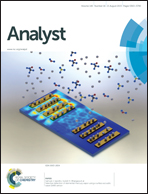A versatile and highly sensitive homogeneous electrochemical strategy based on the split aptamer binding-induced DNA three-way junction and exonuclease III-assisted target recycling†
Abstract
Herein, a highly sensitive and versatile homogeneous electrochemical biosensing strategy is proposed, based on the split aptamer-incorporated DNA three-way junction and the exonuclease (Exo) III-assisted target recycling. The aptamer of adenosine triphosphate (ATP, chosen as the model analyte) is split into two fragments and embedded in single-stranded DNA1 and DNA2, respectively. ATP specifically binds with the split aptamers, bringing DNA1 and DNA2 close to each other, thus inducing the DNA three-way junction formation through the partial hybridization among DNA1, DNA2 and the methylene blue-labelled MB-DNA. Subsequently, MB-DNA is specifically digested by Exo III, releasing a MB-labelled mononucleotide, as well as a DNA1–ATP–DNA2 complex, which acts as the recycled target and hybridizes with another intact MB-DNA to initiate the subsequent cycling cleavage process. As a result, large amounts of MB-labelled mononucleotides are released, generating a significantly amplified electrochemical signal toward the ATP assay. To the best of our knowledge, it is the first example to successfully incorporate split aptamers into DNA three-way junctions and to be adopted in a homogeneous electrochemical assay. In addition to high sensitivity, this strategy also exhibits the advantages of simplicity and convenience, because it is carried out in a homogeneous solution, and sophisticated electrode modification processes are avoided. By simply changing the sequences of the split aptamer fragments, this versatile strategy can be easily adopted to assay a large spectrum of targets. Due to its advantages of high sensitivity, excellent selectivity, versatility and simple operation, the as-proposed approach has great potential to be applied in biochemical research and clinical practices.


 Please wait while we load your content...
Please wait while we load your content...